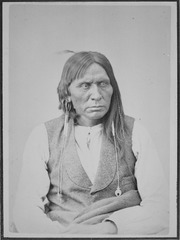Waco people facts for kids

Long Soldier, a Waco man, 1872
|
|
| Total population | |
|---|---|
| fewer than 2,953 (2018) | |
| Regions with significant populations | |
| Oklahoma, historically Texas | |
| Languages | |
| English, Waco, Wichita | |
| Religion | |
| Native American Church, Christianity, indigenous religion |
|
| Related ethnic groups | |
| Caddo, Pawnee, other Wichita and Affiliated Tribes |
The Waco people, sometimes called Huaco or Hueco, are a Native American tribe. They are part of the larger Wichita people and lived in the southern Great Plains region, mainly in what is now northeastern Texas. Today, the Waco are officially recognized by the United States government. They are members of the Wichita and Affiliated Tribes. Their main office is in Anadarko, Oklahoma.
Contents
Waco History
The Waco people were a group within the larger Wichita family. Early European explorers called them Iscani or Yscani. They were also related to the Tawakoni people. The modern city of Waco, Texas, is built where their main village once stood. This village was still active around 1820.
Early European Encounters
In 1719, a French explorer named Jean-Baptiste Bénard de la Harpe traveled through the area. He might have met the Waco people, calling them Honecha or Houecha. They are also likely the "Quainco" shown on a 1718 map by Guillaume de L'Isle. This map was titled Carte de la Louisiane et du Cours du Mississipi.
Life in the Village
The Waco's main village was located along the Brazos River. Two Tawakoni villages, El Quiscat and Flechazos, were nearby. In 1824, a settler named Stephen F. Austin described the Waco village. He said it was about 40 acres in size. It had 33 houses made of grass and was home to about 100 men. The Waco people were skilled farmers. They grew about 200 acres of corn. Their fields were protected by fences made of brush. As late as 1829, the village was also protected by strong earth walls.
In 1830, an anthropologist named Jean-Louis Berlandier counted 60 Waco houses. The tribe also had a smaller village. This second village was located on the Guadalupe River.
Moving to New Lands
In 1837, the Texas Rangers thought about building a fort at the Waco village. However, they decided against it after a few weeks. A trading post was set up 8 miles south of the village in 1844.
The Waco tribe signed agreements with the United States and the Wichita people in 1835, 1846, and 1872. The 1872 agreement created a special area for them called a reservation. This reservation was in Indian Territory, which is now Oklahoma. The Waco people moved there.
In 1902, a law called the Dawes Act changed things. This law divided the reservation lands into smaller, individual plots. The Waco people then became citizens of the United States. Today, they are an important part of the Wichita and Affiliated Tribes.
Waco Culture and Lifestyle
The Waco people built unique homes. Their houses were shaped like beehives. They had strong pole supports. These homes were usually covered with rushes, which are like tall grasses. Sometimes, they used buffalo hides to cover their houses. These houses stood tall, about 20 to 25 feet high.
Besides corn, the Waco people grew many other foods. They farmed beans, melons, and pumpkins. They also grew peach trees, providing them with fruit.
Waco Language
The Waco people spoke their own special language. It was a dialect called Waco. This dialect was part of the Wichita language, which belongs to the Caddoan languages family. Sadly, the Waco dialect is no longer spoken today. It is considered extinct.
Places Named After the Waco
The city of Waco, Texas, gets its name from the Waco tribe. Also, Hueco Springs, which is near New Braunfels, Texas, is likely named after them. "Hueco" is another way to spell Waco.

